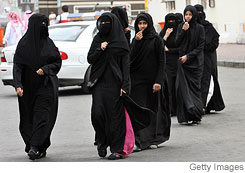In recent years, obesity has been a major part of the health discussion around the world. Statistics stating how obese many kids, women, men, middle-aged, school-aged, and any other category you can think of have been floating around and are highly discussed especially when it comes to the United States. However, more articles have been written in the past couple of years about obesity in the Middle East and how extreme the circumstances are there. Middle Eastern women are particularly affected by this serious health risk, and as I researched, I found that not a single article had the causes of obesity for that particular group of people all figured out.
Let’s start with the basic causes of obesity . . . causes that are generally accepted around the world as issues when it comes to weight. The first two are physical inactivity and access to unhealthy food (or zero access to healthy food). Most people know that a healthy diet and being active are the first two steps to becoming a healthy human being, but people choose to disregard this for a more “comfortable” lifestyle choice. On top of that, surprisingly, there are people in the world that don’t know this is the proper way to fuel your body, because of lack of education and resources. The third cause that I discovered is very dependent on what area of the world you’re examining: wealth. I say that this is an indirect factor in obesity, because with wealth in many countries, comes the ability to buy and eat whatever you may want. It also allows you to stay at home more, which leads to the assumption that you’re not doing hard physical labor to gain the wealth. The last cause is also dependent on your culture: absence of a diet and/or workout culture. This one does not seem to affect the United States in the same way as maybe the other three do, but it certainly affects the Middle East. I don’t know about you, but I’ve never seen a Muslim woman going for a casual afternoon run in her abaya. It’s just not accepted in their culture . . . but we’ll discuss this later on in the post.
Specifically identifying causes of obesity in the Middle East was surprisingly easy, and the list I compiled nearly doubles the previous list. According to an article on Nature Middle East, “the cause of the increase [in obesity] varies between Arab countries depending on socioeconomic, geographical, and cultural differences”, which comes into play when examining obesity in every country in the world, but is extreme when looking at the Middle East. As I mentioned above, women are primarily affected. Nearly 50% of Middle Eastern women are overweight, many of them even ranking as obese on the BMI scale, which is nearly double that of Middle Eastern men. There are specific determining factors that prevent women from losing weight and perpetuate the gaining of that weight.
- Dress codes and “expected” conduct for women
Dress codes and conduct include the abaya, hijab, and having an overall modest appearance and representation of yourself as a woman. I don’t know about you, but running in any modest clothing (long sleeve, long skirt, any kind of scarf around your head) in the Middle Eastern heat does not sound appealing to me. Not to mention, breaking these societal norms could result in punishment. Working out can be a punishment in and of itself… I wouldn’t do it if I knew I was going to be punished afterwards by the men in my life.
***As a side note, abayas also cover the excess weight or the “mark of obesity” . . . which has led to the coining of the phrase “hidden obesity.” It’s the idea that the actual weight is “out of sight, out of mind.” This is something that also plays into the lack of workout culture, because in the U.S., our clothing is so revealing and tight, that you can tell when someone has even an inch of fat on their body, forcing many Americans (especially between the ages of 14 and 24) into a highly-accepted workout culture.
- Middle Eastern Heat
Enough said.
- A more Westernized diet
This “Westernized diet” was introduced into the Middle East three decades ago and added foods like pasta and carbonated beverages to their everyday lives. These foods had not previously been a part of their society or culture, but with the introduction came the more frequent access of it.
- More women going into the workforce
This combined with the Westernized diet affects many families, because women who are working are going to have less time to prepare healthy, home-cooked meals and will likely resort to fast food or quick, easily-made food to provide for their families. Think fries, chicken nuggets, and other things that can be popped in either the microwave or the oven.
- Failure to lose the weight gained during pregnancy
Due to a lack of resources and a decreasing population of doctors who provide care/follow up time with women after pregnancy, women in the Middle East are less likely to lose the baby weight (or the weight gained during pregnancy). Many doctors in the Middle East are not well-trained in nutrition, and therefore don’t know the proper ways to inform women on ways to take care of their bodies post-baby. If a woman has multiple children, that weight will eventually pile up, pushing her into the obese range.
- Sports and recreational facilities being “male only”
This directly prohibits women from most public exercise spaces, which are some of the most convenient places to get a workout in. Without these, women must resort to either exercising at home or not exercising at all.
- Emphasis on Academics
More and more colleges are offering night classes for women, taking up the little-to-no time they had to workout to begin with. The emphasis here is on being academically-minded and preferring an intelligent woman to a thin woman.
Lastly, there is a common fear among women in the Middle East that if they work out, they will gain muscles. They will probably gain some muscle, especially depending on the kinds of exercise they are doing and how often they do it. Because being naturally curvy is more culturally accepted in the Middle East, gaining muscles would be considered unattractive to women in the Middle East. Being “thicker” is a sign of femininity and fertility, and gaining muscles would negate those two concepts in their eyes. However, being curvy and being obese are two different things and women who are obese are actually decreasing their fertility rates. Being obese leads to complications during pregnancy and the excess weight leads to more miscarriages. There are also several other health risks, including diabetes, heart disease, and high cholesterol, among others. The overall lack of awareness about obesity and everything it can affect is a significant issue in the Middle Eastern culture, which has some of the worst obesity statistics in the world.
Resources:
“As obesity rates soar in Middle East, more doctors turn to the knife”






It’s funny, I don’t really think about obesity in any other countries besides the United States. It is interesting to see the more “Western” Middle Eastern societies become, the higher their obesity statistics rise. Nonetheless, I do have a question: Is being overweight a Western phenomenon surrounding our fast-food and consumeristic society? Or is it a Middle Eastern custom where women are considered beautiful and fertile if they carry a little extra weight?
That’s an interesting question, and to be honest, I think it’s a little bit of both. I think fast food and consumerism obviously encourage and perpetuate obesity, but it has long been a Middle Eastern custom that the curvier, the better. I think fast food and “Western” culture has just furthered the Middle Eastern custom from being curvy to being obese to the point of health complications. I think our high calorie and high sugar foods have pushed their custom over the edge.
This was a very interesting read. I enjoyed the breakdown of the various reasons as to why many women are obese, as I had never previously thought of a lot of them.
Going back to your point about wealth at the beginning, I’d say that wealth can also have the opposite affect. Many wealthy people have the means to spend extra money on organic or local food, making their eating habits much healthier. They also have the means to hire a personal trainer, which people with less of an income don’t have the opportunity to do.
I liked how you mentioned the problem that many women are afraid to gain muscle. This holds true in many different cultures, because women are expected to look a certain way without being “too muscular” or “manly” looking. Interestingly though, women are valued for their curves in the Middle East whereas women are valued for a practically anorexic look in America.
It’s always interesting to read about the differences between cultures and how they are similar as well. This article definitely covered a universal issue and highlighted how the reasons for it being a significant issue in different areas of the world are the same in some aspects, but can also be very different. I can personally say that I try to live a very healthy lifestyle and love the way I can transform my body through exercising and this article really opened my eyes to an important value that the women in this culture hold.
While I was overseas this summer in UAE, I never really took the time to think about the obesity rates of Middle Eastern women. I always associated obesity to “Western” culture. I think this blog did a great job at outlining the different reasons why this is on the rise. This blog gave me a new perspective and introduced me to this topic. Nice job!
I’ve read about this topic before and it amazes me how two countries from completely different parts of the world can be struggle with such similar health concerns! I thought the article was well written and showed a broad range of information on the subject. I’m excited to see what you will write next i’ll be sure to check it out!